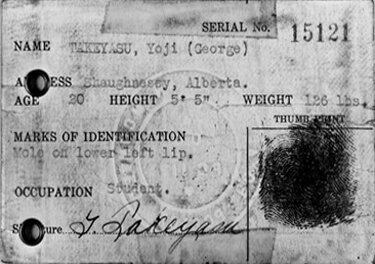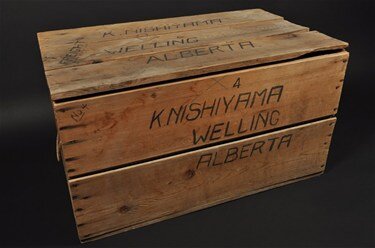Second World War Relocation
Lesson Objectives:
Students will know that Japanese Canadians were evacuated and relocated during the Second World War.
Students will appreciate how the relocation affected the Japanese individually and as a culture.
Students will analyze how fear and mistrust are expressed by countries during stressful times and what societies can learn from these experiences.
Curriculum Connections:
4.2 The Stories, Histories and Peoples of Alberta
4.2.1 Appreciate how an understanding of Alberta’s history, peoples, and stories contribute to their own sense of belonging & identity
Recognize how stories of people and events provide multiple perspectives on past and present events (Identity; Time, Continuity and Change)
4.2.2 Asess, critically, how the cultural and linguistic heritage and diversity of Alberta has evolved over time by exploring and reflecting upon the following questions and issues:
How did the arrival of diverse groups of people determine the establishment and continued growth of rural and urban communities? (Culture and Community; Global Connections; The Land: Places and People)
4.3 Alberta: Celebrations and Challenges
4.3.3 Examine, critically, Alberta’s changing cultural and social dynamics by exploring reflecting upon the following questions and issues:
In what ways has Alberta changed demographically since 1905?
5.2 Histories and Stories of Ways of Life in Canada
5.2.1 Appreciate the complexity of identity in the Canadian context
Acknowledge the contributions made by diverse cultural groups to the evolution of Canada (Culture and Community; Identity; Time, Continuity and Change)
Recognize how changes in society can affect identity (Culture and Community; Identity)
5.3 Canada: Shaping an Identity
5.3.1 Appreciate how changes impact citizenship and identity
Recognize how economic and political changes impact ways of life of citizens (Citizenship; Economics and Resources; Identity; Power, Authority and Decision Making)
7.2 Following Confederation: Canadian Expansion
7.2.1 Recognize the positive and negative aspects of immigration and migration (Global Connections; The Land: Places and People; Citizenship; Identity)
7.2.2 Recognize the positive and negative consequences of political decisions (Power, Authority and Decision Making)
7.2.5 Evaluate the impact of Confederation and of subsequent immigration to Canada from 1867 to the First World War by exploring and reflecting upon the following questions and issues:
How did Asian immigrants contribute to the development of Canada (i.e., Chinese railway workers)? (Time, Continuity and Change; Culture and Community; The Land: Places and People)
Activities:
Have students watch the Relocation animation.
As you watch the video, ask your students to think about the following questions:
What surprised you in the video?
What upset you in the video?
Were you aware that Japanese Canadians had been relocated in the Second World War?
Have students read: Idosha (The Evacuees)- Cultural Shame (or read as a class).
A couple hundred Japanese Canadians lived in southern Alberta prior to the 1940s. Then in the 1940s approximately 2500 more were relocated to southern Alberta. Many worked in the sugar beet fields in southern Alberta – helping supply a labour force. Arrangements were made between the Alberta government and the British Columbia government that the Japanese would leave Alberta following the war and would not be permitted to live in the cities. These rules were not followed after the war and many of the Japanese Canadians remained in southern Alberta.
Some of the people moved to southern Alberta were Issei (First Generation) but many were Nissei (Second Generation). The Nissei had been born and raised in Canada and were Canadian citizens.
In the evacuation, children were permitted to take 34 kg (75 lbs.) of possessions and adults 68 kg (150 lbs.). The families often had only 24 hours notice in order to pack up their belongings and they had no idea of their destination. In many cases, mothers and children were forced to do the packing and to decide what to pack as the fathers and sons over 18 years of age had already been sent away. The mothers and children were also responsible for carrying their own luggage. Look around your house. What would you pack? What would you leave behind? Is this a difficult decision? Do you take your best stuff with you? Or leave your best stuff behind thinking it is safer there? Have each student go home and make a list of what items they would take and which ones they left behind. Have a few students share their list and talk about their decisions.
Introduce the photograph of the shipping crate. Prior to being sent to southern Alberta, many of the Japanese knew very little about the place. They, however, heard rumours and stories. The Nishiyama family was told that there were no trees anywhere on the prairies and that it would be impossible to build a fire (for cooking, heating, etc). While in British Columbia, the family built several shipping crates out of wood - so they would have something to burn when they arrived. Once in southern Alberta, they found it was not necessary to burn the crates and kept them for years in their home (even using one as a coffee table).
Discuss with your class the idea of going into the unknown where all you have are stories and rumours.
Read to the class this quote from Mr. and Mrs. Eiji Tashiro.
“There were crowds of people, farmers and newsmen. We tried to hide and avoid having our pictures taken. Wagons, horses and tractors waited to take us. It was like some slave trading market. We were terrified, not knowing where we were going. Some of us didn’t want to move. Women were crying. The farmers hurried us.”
Discuss with your class being moved from your home, sent to some far off place and then going to work in the sugar beet fields. How would you feel? What questions would you have?
Show your students the photograph of the evacuation card. Japanese Canadians were required to check in and had to carry identification with them. They were fingerprinted and information on their location was kept by the Royal Canadian Mounted Police.
Imagine you are one of the children who has moved with your family. Write down three questions you have about why the evacuation happened. Draw a picture about how you feel about the evacuation.
Either as an extension of the above activity or as an alternative to the above activity, draw a picture of the belongings you have chosen to bring along. Write a journal entry about how you felt the day you had to pick out the belongings and pack your bags.
Or students may wish to create their own cartoon along the lines of the animated video. Create a four part sequence of yourself using the following scenarios:
A picture of yourself in your current house with your favourite things.
Another scene of you and your family being taken away. Show the possessions that you have with you.
Show how you feel on the day that you and your family are being taken away.
Draw a picture of yourself and your family in your new home near the sugar beet fields. What possessions do you have in your house? What is different from your house today?
Materials/Equipment:
Extension Activities
“Japanese Canadians have a special role in this society. As the major group against whom a massive suspension of civil rights was unjustly and cruelly invoked, we owe it to the people of this country to constantly remind them of what fear and prejudice can do.”
David Suzuki
Questions (these may be more appropriate for Grades 7 and older):
What are the basic human rights that people in Canada have every day?
What rights does/should a country have to restrict people during a war? Under what circumstances?
Fear is a powerful motivator for countries and for people. The people of Canada were living in fear during the Second World War (we have to remember we are viewing the war with hindsight and an awareness of how it ended). What should people do when they’re scared? If one of your friends was making a decision when they were scared, what would you encourage them to do?
Was the Canadian government justified in interring Japanese Canadians during the Second World War? Why or why not? Were the Albertan and Lethbridge governments justified in not permitting Japanese Canadians to live in Lethbridge until 1950? Why or why not?
Students will discuss the concepts of civil rights and exclusion and what it means to be a Canadian in a tolerant, multicultural society.
Students may wonder if similar things happened to Italian Canadians and German Canadians during the Second World War. Have students research the experience of other groups during the Second World War.




